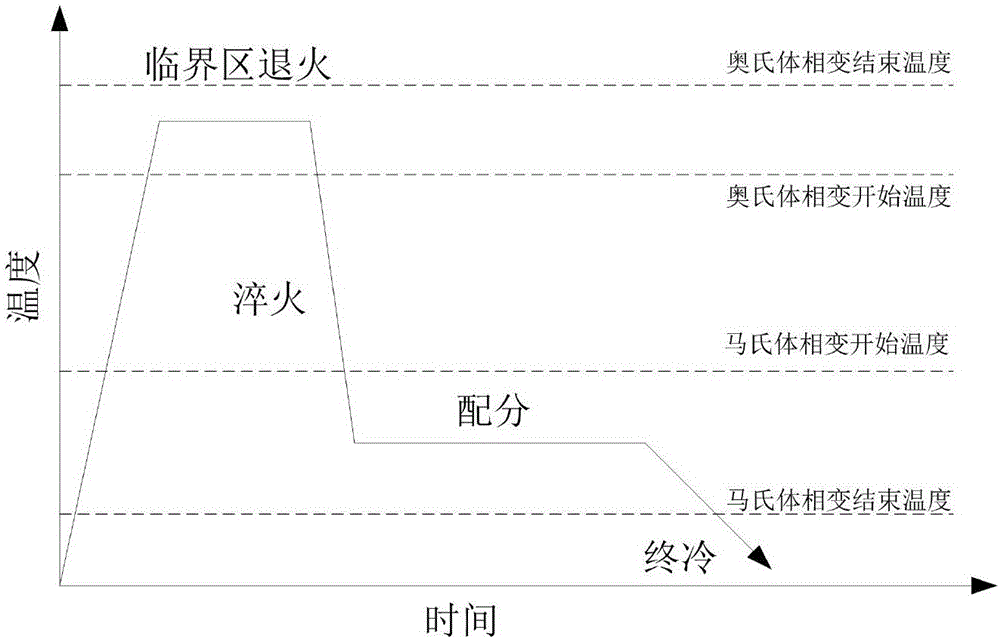Medium-manganese TRIP (Transformation-Induced Plasticity) steel and preparation method thereof
A technology of quenched steel and cold-rolled steel plate, applied in the field of medium manganese TRIP steel and its preparation, can solve the problems of lower elongation, lower elongation, less retained austenite, etc., and achieve industrial production, lower mechanical properties, The effect of stable performance
- Summary
- Abstract
- Description
- Claims
- Application Information
AI Technical Summary
Problems solved by technology
Method used
Image
Examples
Embodiment 1
[0067] Its components are calculated by weight percentage: C: 0.21%; Mn: 4.8%; Si: 1.4%; the rest is Fe and other unavoidable impurities.
[0068] According to the above ingredients, smelt in a 50kg vacuum induction furnace, and forge into a billet (steel billet), heat the billet to 1200°C with the furnace, and keep it warm for 2 hours;
[0069] Then rolling on a hot rolling mill, the rough rolling start temperature is controlled at 1100°C, and the finish rolling finish temperature is controlled at 880°C;
[0070] Water cooling to the coiling temperature, the coiling temperature is controlled at 550°C, and kept for 2 hours;
[0071] The hot-rolled steel plate is pickled and cold-rolled into a chilled plate with a thickness of 1mm;
[0072] Heat the chilled plate to 675°C at a heating rate of 10°C / s, and keep it isothermally for 5 minutes;
[0073] Then quickly cool (>20°C / s) to 250°C and wait for 10 seconds;
[0074] Then heated to the partition temperature of 325 ° C, isot...
Embodiment 2
[0078] Each component is calculated by weight percentage: C: 0.18%; Mn: 5.3%; Si: 1.3%; the rest is Fe and other unavoidable impurities.
[0079] According to the above composition, it is smelted in a 50kg vacuum induction furnace and forged into a billet (steel billet);
[0080] The billet is heated to 1150°C with the furnace and kept for 3 hours.
[0081] Then rolling on a hot rolling mill, the rough rolling start temperature is controlled at 1050°C, and the finishing rolling finish temperature is controlled at 850°C;
[0082] Water cooling to the coiling temperature, the coiling temperature is controlled at 600°C, and kept for 1.5 hours;
[0083] The hot-rolled steel plate is pickled, cold-rolled into a chilled plate with a thickness of 2.0mm, and then heat-treated;
[0084] Heat the chilled plate to 700°C at a heating rate of 15°C / s, and keep it isothermally for 2 minutes;
[0085] Then quickly cool (>20°C / s) to 280°C and wait for 10 seconds;
[0086] Then heated to th...
Embodiment 3
[0090] Each component is calculated by weight percentage: C: 0.15%; Mn: 4.5%; Si: 1.5%; the rest is Fe and other unavoidable impurities;
[0091] According to the above composition, it is smelted in a 50kg vacuum induction furnace and forged into a billet (steel billet);
[0092] The billet is heated to 1250°C with the furnace and kept for 3 hours.
[0093] Then rolling on a hot rolling mill, the rough rolling start temperature is controlled at 1050°C, and the finishing rolling finish temperature is controlled at 900°C;
[0094] Cool in water to the coiling temperature, the coiling temperature is controlled at 500, and keep warm for 2 hours;
[0095] The hot-rolled steel plate is pickled, cold-rolled into a chilled plate with a thickness of 0.6-2.0mm, and then heat-treated;
[0096] Heat the chilled plate to 650°C at a heating rate of 15°C / s, and keep it isothermally for 5 minutes;
[0097] Then quickly cool (>20°C / s) to 240°C and wait for 10 seconds;
[0098] Then heated ...
PUM
| Property | Measurement | Unit |
|---|---|---|
| tensile strength | aaaaa | aaaaa |
| yield strength | aaaaa | aaaaa |
| tensile strength | aaaaa | aaaaa |
Abstract
Description
Claims
Application Information
 Login to View More
Login to View More - R&D
- Intellectual Property
- Life Sciences
- Materials
- Tech Scout
- Unparalleled Data Quality
- Higher Quality Content
- 60% Fewer Hallucinations
Browse by: Latest US Patents, China's latest patents, Technical Efficacy Thesaurus, Application Domain, Technology Topic, Popular Technical Reports.
© 2025 PatSnap. All rights reserved.Legal|Privacy policy|Modern Slavery Act Transparency Statement|Sitemap|About US| Contact US: help@patsnap.com

